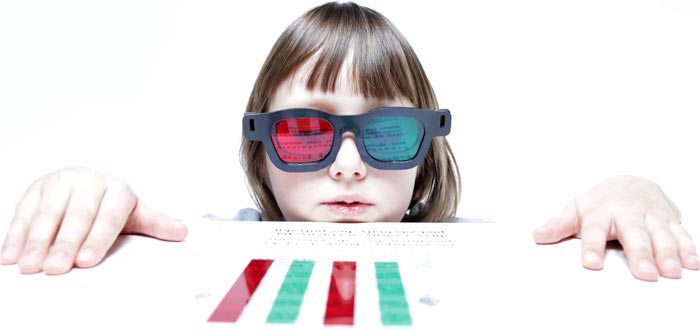| |
|
VISION THERAPY IS NOT JUST
EYE EXERCISES!
The goal of optometric vision therapy ("VT") is not to
strengthen eye muscles. Your eye muscles are already incredibly
strong, and the vision problems VT aims to treat are rarely
caused by muscle weakness. Optometric vision therapy is
supported by ongoing evidence-based scientific research. |
| |
|
| Vision therapy is safe, drug-free, and effective for both children and adults! While visual acuity (the "20/20" part of vision) requires glasses to improve, visual skills such as tracking together along a line of text must be learned during development, these skills can also be improved later in life at any age. |
What is Visual Training?
 |
First we need to understand what vision is. Nearly all
humans are born with the potential for good eyesight,
but vision the ability to identify, interpret and
understand what is seen is learned and developed,
starting at birth.
In learning to walk, a child begins by creeping,
crawling, standing, walking with assistance, and
finally, walking unaided. A similar process from gross
to fine motor control takes place in the development of
vision.
One visual skill builds on another, step-by-step. But many people miss
or don't complete a step, or must begin to perform school or other visually
demanding tasks before an acceptable foundation of basic
visual skill is in place. |
|
|
Science indicates that we do not see with our eyes or
our brain; rather, vision is the reception and
processing of visual information by the total person.
Since two-thirds of all information we receive is
visual, it becomes clear that efficient visual skills
are a critical part of learning, working and even
recreation. Athletes, for example, use visual training
for improved performance in their sport.
Developing visual skills includes learning to use both
eyes together effectively. Having both eyes move, align,
fixate and focus as a team enhances your ability to
interpret and understand the potential visual
information that is available to you.
Intelligent persons who are very highly motivated can be
good achievers, even with very poor visual skills and
abilities, but at untold cost in wasted energy, effort and stress. For those who are less
motivated, even one or two deficient visual skills can
produce enough stress and frustration to create a
non-achiever. |
|
|
| The visual skills which can be developed and enhanced
through visual training include: |
|
Tracking: |
The ability to follow a moving object
smoothly and accurately with both eyes, such as a ball
in flight or moving vehicles in traffic. |
|
Fixation: |
The ability to accurately locate
and inspect with both eyes a series of stationary
objects, one after another, such as moving from word to
word while reading. |
|
Focus Change: |
The ability to look quickly from far to
near and vice versa without momentary blur, such as
looking from the chalkboard to a book or from the
dashboard to cars on the street. |
|
Depth Perception: |
The ability to judge relative
distances of objects and to see and move accurately in
three-dimensional space, such as when hitting a ball or
parking a car. |
|
Peripheral Vision: |
The ability to monitor and
interpret what is happening around you while you are
attending to a specific central visual task; the ability
to use visual information perceived from over a large
area. |
|
Binocularity: |
The ability to use both eyes together,
equally, simultaneously and accurately. |
|
Maintaining attention: |
The ability to keep doing any
particular skill or activity with ease and with
interfering with the performance of other skills. |
|
Near Vision Acuity: |
The ability to clearly see,
inspect, identify and understand objects at near
distances, within arm s length. |
|
Distance Acuity:
|
The ability to clearly see, inspect,
identify and understand objects at a distance. People
with 20/20 distance sight still may have visual
problems. |
|
Visualization:
|
The ability to form mental images in
your mind s eye, retain them for future
recall, or for synthesis into new mental images beyond
your current or past direct experiences. |
|
|
|
|
Optometric visual training, sometimes called vision
therapy or VT, is that part of optometric care devoted
to developing, improving and enhancing people s visual
performance. Vision therapy can benefit people of all
ages. Optometrists have developed and used visual
training for several decades to: |
| Prevent
vision and eye problems from developing. |
| Develop the
visual skills needed to achieve more effectively
at school, work or play. |
| Enhance
functioning on tasks demanding sustained visual
effort |
| Remediate or
compensate for vision and eye problems which
have already developed. |
|
|
|
|
Visual training also has proven to be a remarkably
effective tool in helping people with learning-related
visual problems. Many problems in learning to read and
write are made worse by poorly developed visual skills.
Dozens of experimental programs involving thousands of
children and adults demonstrate that when visual skills
are enhanced through visual training, learning is
easier, reading levels rise, and in some cases, IQ
scores have increased. Building visual skills also
increases the ability to visualize, conceptualize and to
create. |
|
|
 |
|
|
Vision therapy (visual training, vision training) is an
individualized supervised treatment program designed to
correct visual-motor and/or perceptual-cognitive
deficiencies which have various causes, such as:
inadequate sensorimotor development
trauma to the nervous system (i.e., birth injury,
brain trauma, closed head trauma, etc.)
stress
in some cases, contributing hereditary factors (i.e.,
crossed-eyes, wandering eyes)
|
|
Vision therapy trains the entire visual system which
includes eyes, brain and body. However, it is important
to understand that vision therapy is a form of
neurological training or rehabilitation (it can be
compared to some forms of occupational therapy or
physical therapy). The goal of vision therapy is to
train the patient's brain to use the eyes to receive
information effectively, comprehend it quickly and react
appropriately.

Vision therapy sessions include procedures designed to
enhance the brain's ability to control eye alignment,
eye movements, focusing abilities, and eye teamwork
(binocular vision). Visual-motor skills and endurance
are developed through the use of concentrated computer
and optical devices, including therapeutic lenses,
prisms and filters. During the final stages of therapy,
the patient's newly acquired visual skills are
reinforced and made automatic through repetition and by
integration with motor and cognitive skills. |
|
|
|
|